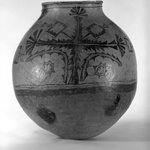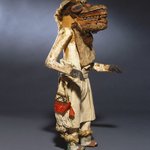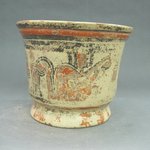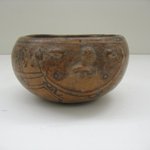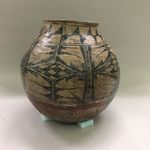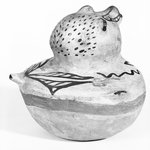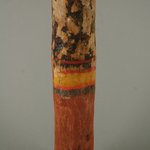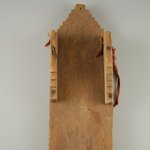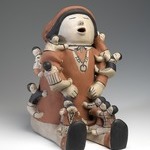
Water Jar or Olla
Arts of the Americas
On View: Luce Visible Storage and Study Center, 5th Floor
NATIVE AMERICAN PUEBLO POTTERY
Pottery making was practiced in the southwestern United States for at least two thousand years. Zuni and Cochiti potters created the three vessels here: two water jars and one drum jar, which would have had a hide stretched over the top for beating with drumsticks. Historically, women were the potters, collecting their own clays, coiling and finishing each pot by hand, and firing the pieces in open fires.
Pots were often traded and exchanged between pueblos, so that new ideas were constantly being generated. During the 1880s the advent of the railroad brought an influx of trading posts and tourists into the Southwest and entrepreneurial potters began selling to the non-Native market. Today, both male and female potters continue to form traditional works as well as generate exciting new forms of Pueblo pottery.
Pottery making was practiced in the southwestern United States for at least two thousand years. Zuni and Cochiti potters created the three vessels here: two water jars and one drum jar, which would have had a hide stretched over the top for beating with drumsticks. Historically, women were the potters, collecting their own clays, coiling and finishing each pot by hand, and firing the pieces in open fires.
Pots were often traded and exchanged between pueblos, so that new ideas were constantly being generated. During the 1880s the advent of the railroad brought an influx of trading posts and tourists into the Southwest and entrepreneurial potters began selling to the non-Native market. Today, both male and female potters continue to form traditional works as well as generate exciting new forms of Pueblo pottery.
CULTURE
Ko-Tyit (Cochiti Pueblo)
MEDIUM
Ceramic, pigment
DATES
late 19th century
DIMENSIONS
19 3/4 × 15 × 15 in. (50.2 × 38.1 × 38.1 cm)
diameter at opening: 8 7/8 in. (22.5 cm) (show scale)
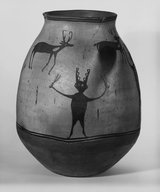


INSCRIPTIONS
Catalogue number written in ink in middle of body surface. Small gummed label (20) is inside.
COLLECTIONS
Arts of the Americas
ACCESSION NUMBER
02.257.2471
CREDIT LINE
Riggs Pueblo Pottery Fund
CATALOGUE DESCRIPTION
Jar with a grey body with the upper 3/4 covered with a brownish-white slip. The bottom has a red slip. A black design covers 3/4 of the body, seperated from the bottom by two black lines. The design is four human figures, two with bows and arrows, two with headdresses, and a row of four smaller deer along the top. Two black lines are at rim.
Four chips in rim, one large chip leading to a crack halfway down one side. One large black spot from firing, one brown discoloration near bottom.
EXHIBITIONS
MUSEUM LOCATION
This item is on view in Luce Visible Storage and Study Center, 5th Floor
CAPTION
Ko-Tyit (Cochiti Pueblo). Water Jar or Olla, late 19th century. Ceramic, pigment, 19 3/4 × 15 × 15 in. (50.2 × 38.1 × 38.1 cm). Brooklyn Museum, Riggs Pueblo Pottery Fund, 02.257.2471. Creative Commons-BY (Photo: Brooklyn Museum, 02.257.2471_bw_SL5.jpg)
IMAGE
overall, 02.257.2471_bw_SL5.jpg. Brooklyn Museum photograph
"CUR" at the beginning of an image file name means that the image was created by a curatorial staff member. These study images may be digital point-and-shoot photographs, when we don\'t yet have high-quality studio photography, or they may be scans of older negatives, slides, or photographic prints, providing historical documentation of the object.
RIGHTS STATEMENT
Creative Commons-BY
You may download and use Brooklyn Museum images of this three-dimensional work in accordance with a Creative Commons license. Fair use, as understood under the United States Copyright Act, may also apply.
Please include caption information from this page and credit the Brooklyn Museum. If you need a high resolution file, please fill out our online application form (charges apply).
For further information about copyright, we recommend resources at the United States Library of Congress, Cornell University, Copyright and Cultural Institutions: Guidelines for U.S. Libraries, Archives, and Museums, and Copyright Watch.
For more information about the Museum's rights project, including how rights types are assigned, please see our blog posts on copyright.
If you have any information regarding this work and rights to it, please contact copyright@brooklynmuseum.org.
RECORD COMPLETENESS
Not every record you will find here is complete. More information is available for some works than for others, and some entries have been updated more recently. Records are frequently reviewed and revised, and we welcome any additional information you might have.















